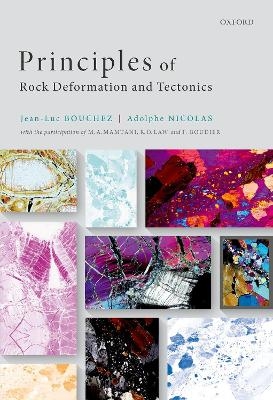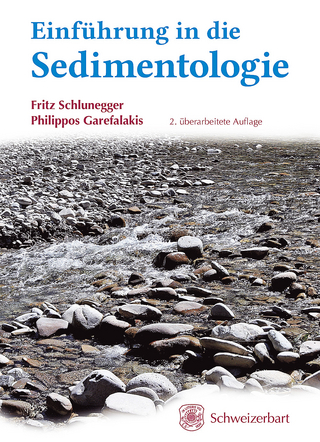
Principles of Rock Deformation and Tectonics
Oxford University Press (Verlag)
978-0-19-284387-6 (ISBN)
This book originates in the French classic "Principes de Tectonique" (Masson, 1983), written by professor Adolphe Nicolas, and the more recent "Principes de Tectonique" by J.L. Bouchez and A. Nicolas (De Boeck, 2018). This English edition is an up-to-date and augmented version that keeps the concise and rigorous writing of its inspiring predecessors. It is largely based on laboratory and field experience of both authors, with a focus towards hard rocks and magmatic rocks from both the continental crust worldwide and the mantle, principally from the Oman ophiolites.
The book includes more than 250 illustrations, most of them original. In addition to classic geological subjects, the book includes elements such as plastic deformation of ice, quartz and olivine, fabric acquisition in rocks and magmas, measurement and orientation of stress, together with basic background information on neotectonics, geophysics and other practical tools such as magnetic fabrics not commonly treated in geological books. Since the targeted readers are present day young students, a few exercises of structural geology are included to improve their abilities.
This book aims principally at students of Geology, at both the undergraduate and graduate levels. However, due to its numerous illustrations and rather concise writing, anyone interested in rock deformation and/or tectonics will find key answers in this book.
Professor Jean-Luc Bouchez (1946-) After his academic studies at Grenoble University (France) in Physics and Earth Science, Jean-Luc Bouchez became assistant professor at Nantes University (France) under the direction of Adolphe Nicolas until 1986. He then attended the Observatoire Midi-Pyrénées (Toulouse University), doing teaching and research worldwide (Africa, Brazil, Iran, Spain, Portugal ...) concerning principally mineral and magnetic fabrics, natural plasticity of quartz-rich rocks, and emplacement of granite plutons. He was awarded the Louis Barrabé Medal at the French Geological Society. Professor Adolphe Nicolas (1936-2020) After his academic studies at University of Paris in Physics and Earth Sciences, he became assistant professor at the School of Mines in Nancy (France), then professor, first at the University of Nantes, up to 1986, where he set up his Petrophysics Laboratory, which then moved to Montpellier University. He was a specialist of peridotites and ophiolites, particularly from Oman. Adolphe Nicolas wrote several books, among which "Principes de Tectonique" (1984), and was awarded several distinctions: Fellow of the American Geophysical Union (AGU); Veinig Meinez Medalist; Member of The Institut Universitaire de France; Dolomieu Award of the French Academy of Sciences; Harry Hess Medal of the AGU.
Forewords and Acknowledgements
1 Deformation/strain and stress
1.1: Deformation / strain
1.2: Stress
1.3: Stress-strain relationships
2 Brittle deformation
2.1: Fracture modes
2.2: Coulomb's law of failure and the Mohr fracture envelope
2.3: Rupture under different conditions
2.4: In-situ stress measurements
2.5: The brittle-ductile transition
3. Brittle deformation structures
3.1: Joint, fissure, cleavage and barren fracture
3.2: Tension fractures
3.3: Faults
3.4: Dynamic analysis of faults
4. Ductile deformation and microstructures
4.1: Cataclastic deformation and granular materials
4.2: Plasticity due to movement of dislocation
4.3: Solid state diffusion flow
4.4: Fluid-assisted flow mechanisms
4.5: Localization of deformation and shear zones
4.6: A few distinctive microstructures
4.7: (T, s, e') deformation maps
5 Macroscopic imprints of ductile deformation
5.1: A few notions about folds
5.2: Planar structures
5.3: Linear structures
5.4: Relationships between lineations, fold-axes and strain ellipsoids
5.5: Terminology conventions
6. Fabrics and kinematic analysis of quartzites, ice and peridotites
6.1: Development of preferred orientations
6.2: Coaxial and non-coaxial lattice fabrics
6.3: Fabric representation: the orientation diagram
6.4: Fabrics and kinematic analysis
6.5: Examples of fabrics
6.6: Past and present mantle flow
7 Magmatic fabrics, structures and microstructures
7.1: Some rheological aspects
7.2: Microstructures: magmatic, orthogneissic and mylonitic
7.3: Magmatic fabric acquisition in plutons
7.4: Magmatic fabrics in plutons
7.5: Injections in magmatic complexes: mixing and mingling
7.6: The Bushveld and Skaergaard mafic complexes
7.7: Gabbros from the oceanic crust
8 Rheology of the lithosphere and states of stress
8.1: Rheological profile of the lithosphere: the Christmas tree
8.2: Mechanical anisotropy of the lithosphere
8.3: Focal mechanisms of earthquakes
8.4: Stress concentration
8.5: From the stress bulb to the Indian indenter
8.6: States of stress in France and around the World
9 Horizontal / vertical displacements and their rates
9.1: Horizontal displacements and rates
9.2: Vertical displacements
10. Technical aspects of tectonics
10.1: Tensorial representation of deformation
10.2: Tensorial representation of stress
10.3: Wülff and Schmidt nets
10.4: The universal stage
10.5: The texture goniometer
10.6: The EBSD technique
10.7: Digital images and shape preferred orientations (SPO)
10.8: Anisotropy of magnetic susceptibility (AMS)
10.9: Gravimetric analysis
11. Practical exercises
11.1: Application of Mohr diagram in structural geology
11.2: Internal inclusions in garnets
11.3: Introduction to orientation diagrams
11.4: Fold-axis construction : an example from the field
11.5: Unravelling structure entanglements
11.6: Looking for past states of stress: paleostress analysis
11.7: Looking for successive states of stress in the Lefkas region (Greece)
11.8: Looking for a local state of stress
11.9: Isostasy, the very base of vertical movements
Index
| Erscheinungsdatum | 05.10.2021 |
|---|---|
| Zusatzinfo | 268 illustrations, 26 in colour |
| Verlagsort | Oxford |
| Sprache | englisch |
| Maße | 178 x 252 mm |
| Gewicht | 670 g |
| Themenwelt | Naturwissenschaften ► Geowissenschaften ► Geologie |
| Naturwissenschaften ► Physik / Astronomie ► Thermodynamik | |
| ISBN-10 | 0-19-284387-7 / 0192843877 |
| ISBN-13 | 978-0-19-284387-6 / 9780192843876 |
| Zustand | Neuware |
| Haben Sie eine Frage zum Produkt? |
aus dem Bereich


